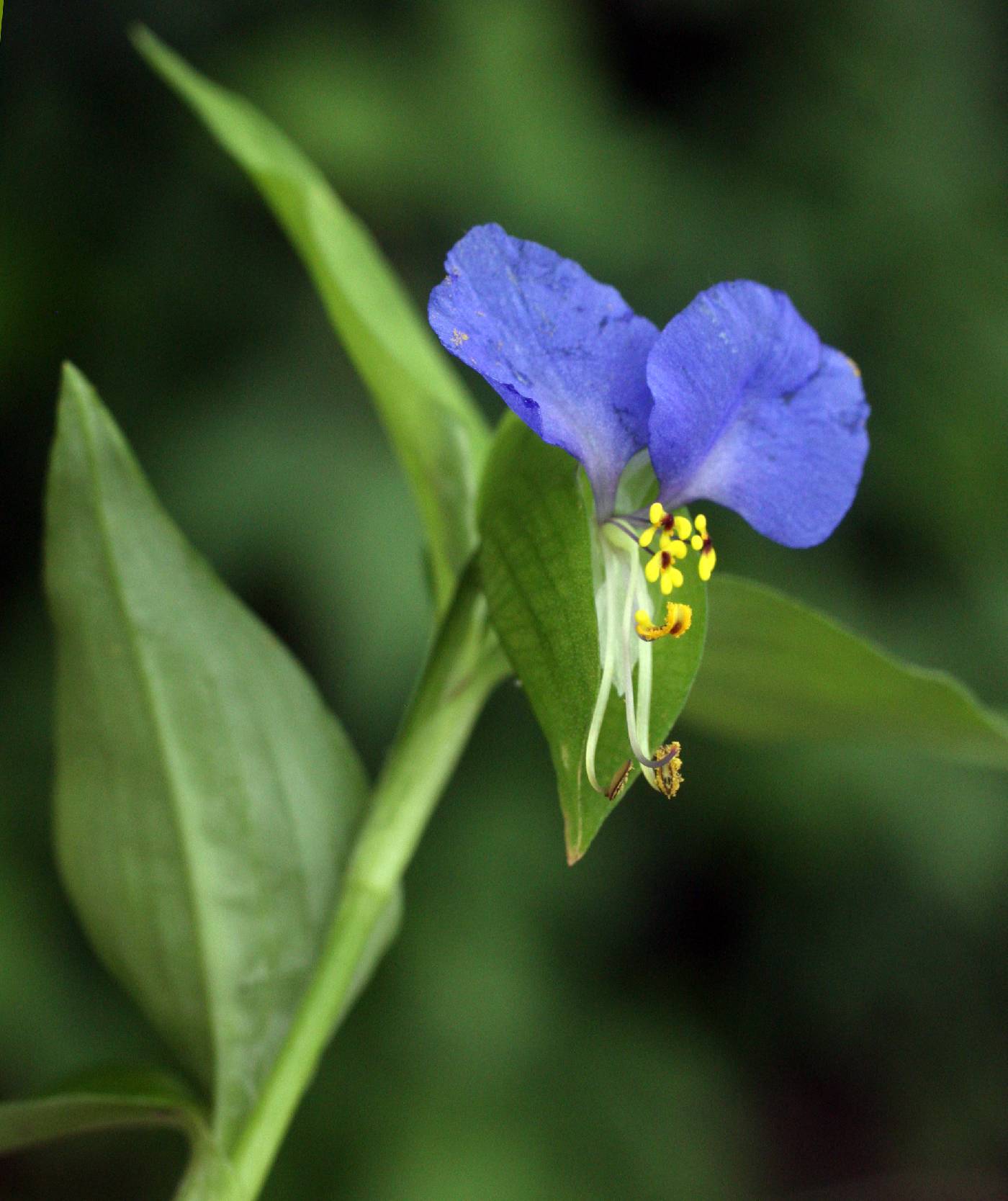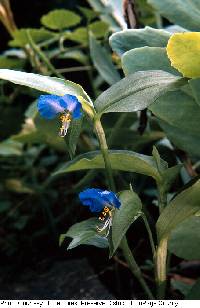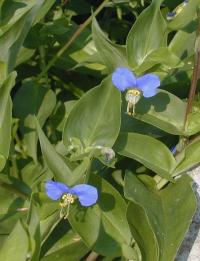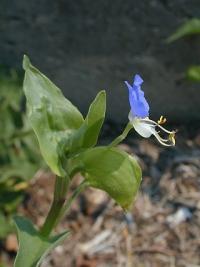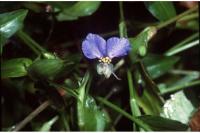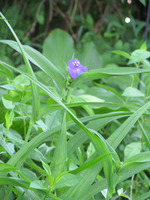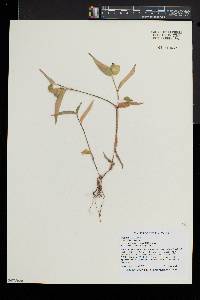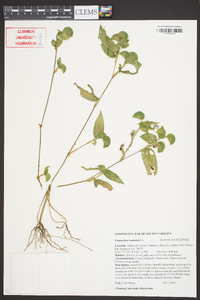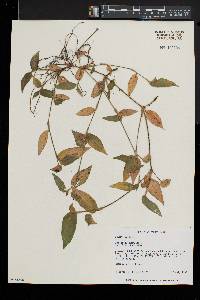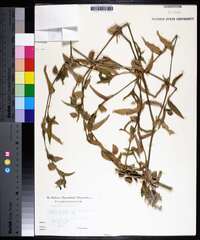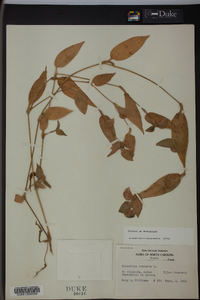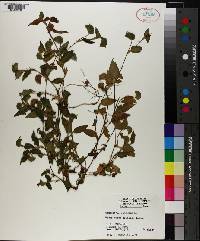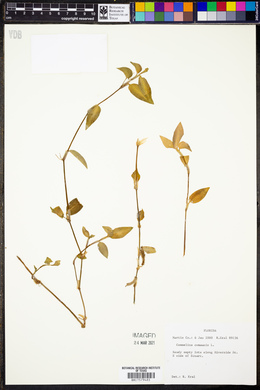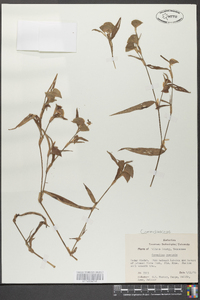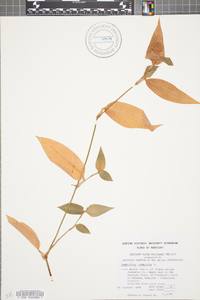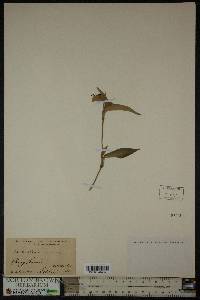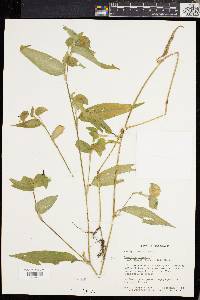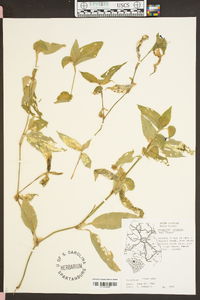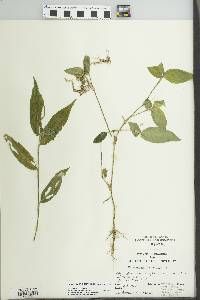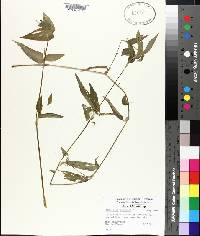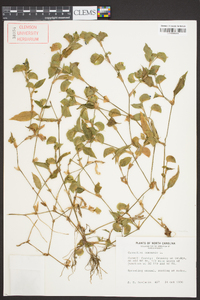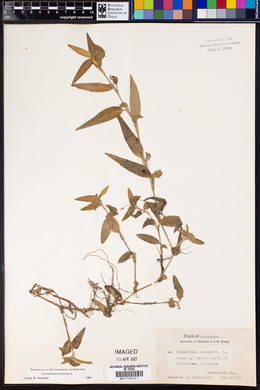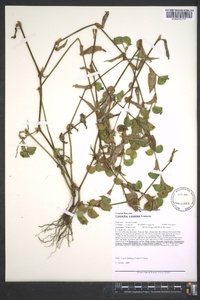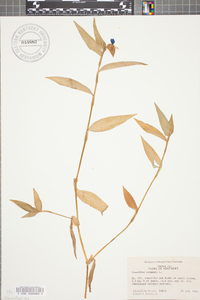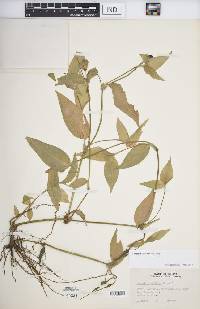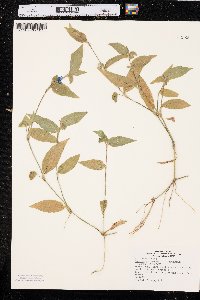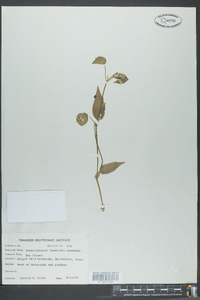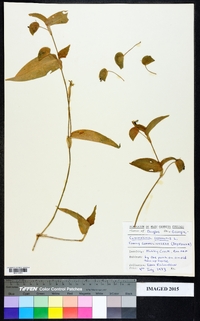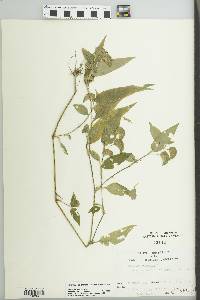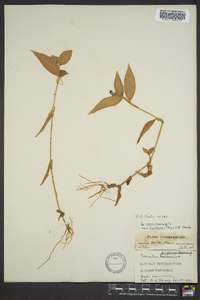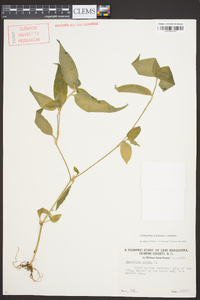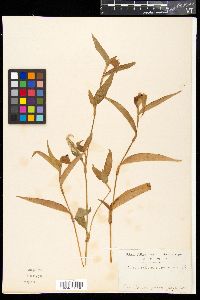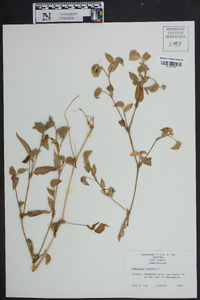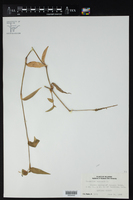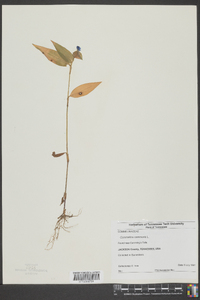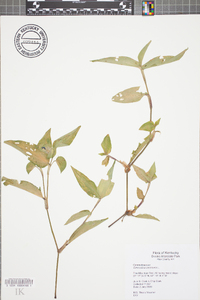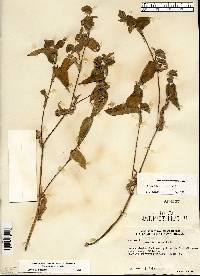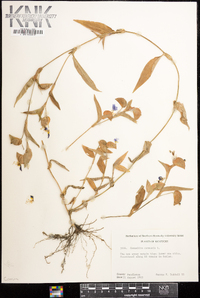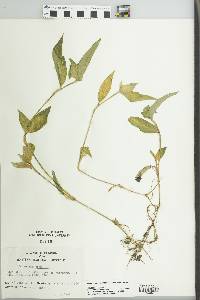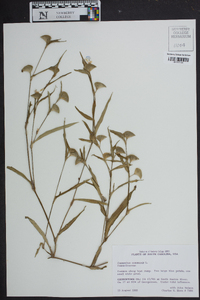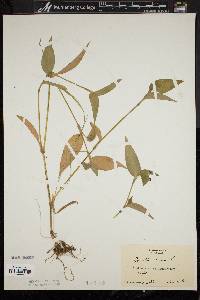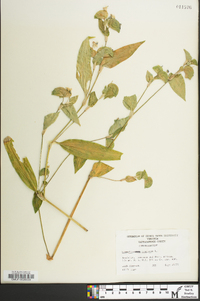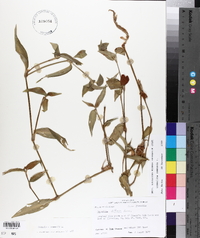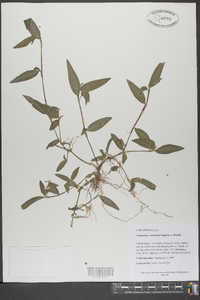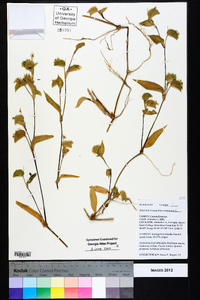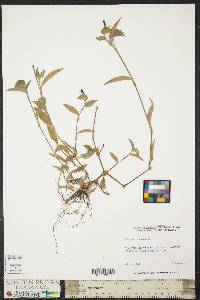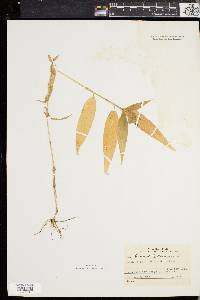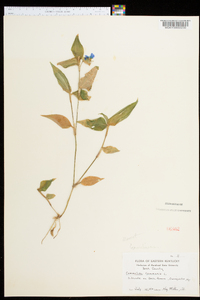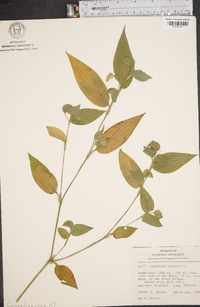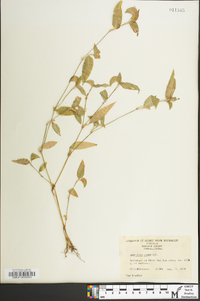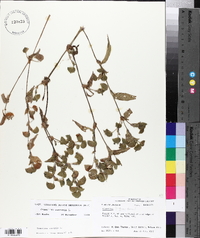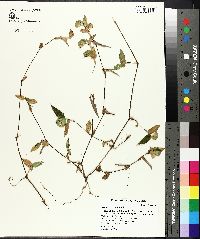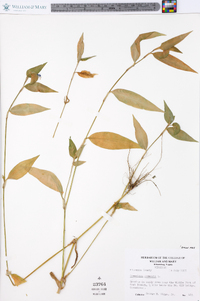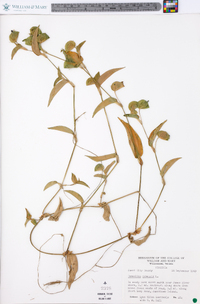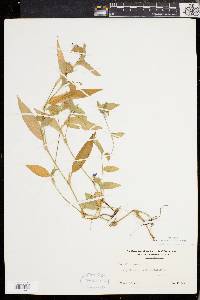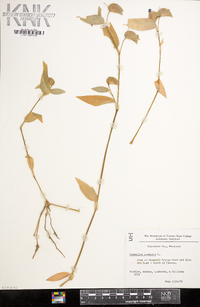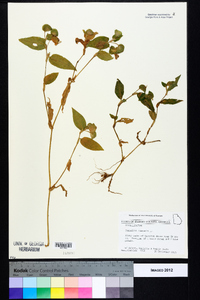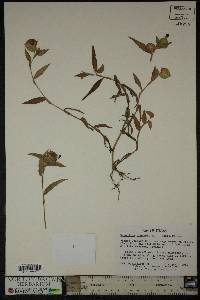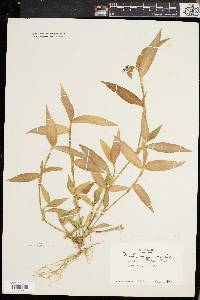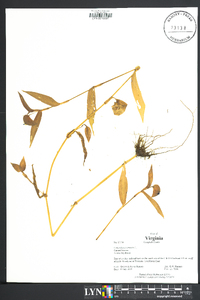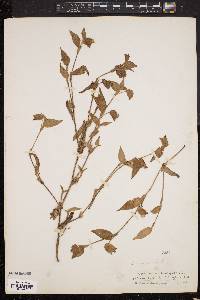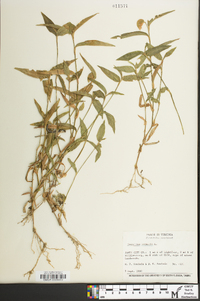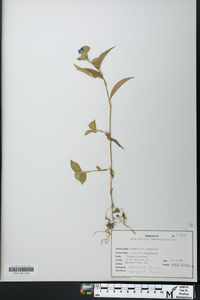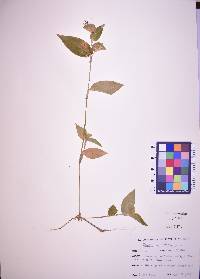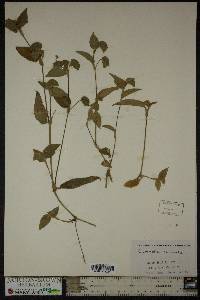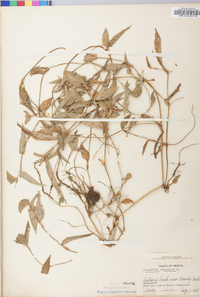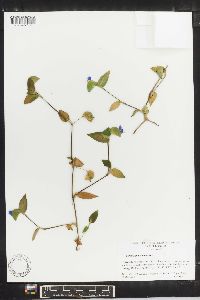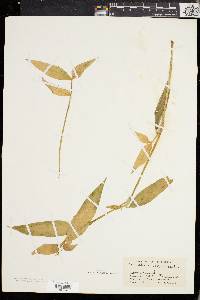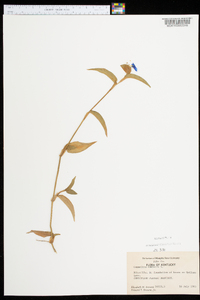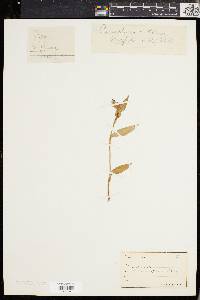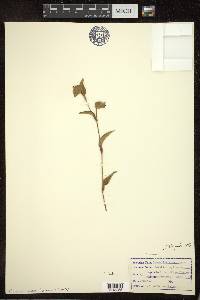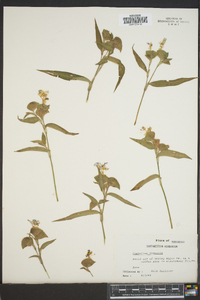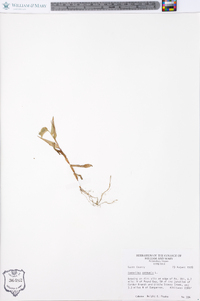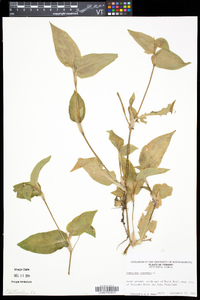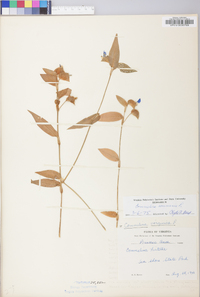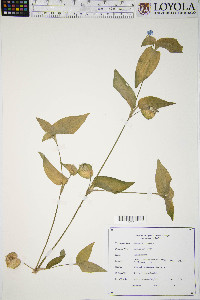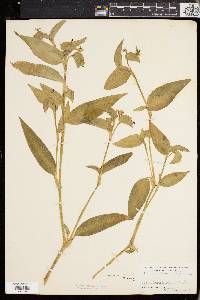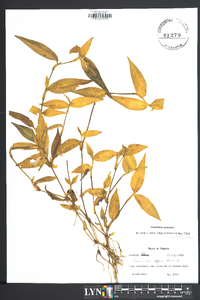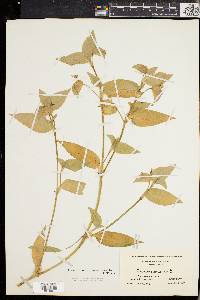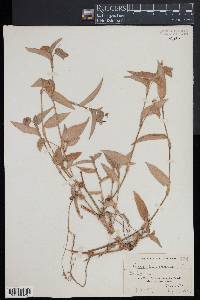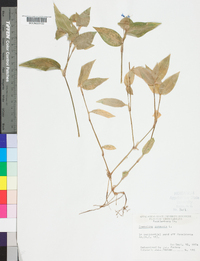
|
|
|
|
Family: Commelinaceae
Asiatic Dayflower, more...common dayflower
|
Herbs, annual, erect to decumbent. Roots at proximal nodes. Stems diffusely branched. Leaves: blade narrowly lanceolate to ovate-elliptic, 5--12 ´ 1--4 cm, apex acute to acuminate. Inflorescences: distal cyme usually vestigial, included, sometimes 1-flowered, exserted; spathes solitary, green, paler or whitish basally with contrasting, dark green veins, pedunculate, usually not falcate, 1.5--3(--3.5) ´ 0.8--1.3(--1.8) cm, margins distinct, scabrous, not ciliate, apex acute to acuminate, glabrous to puberulent; peduncles 0.8--3.5(--5) cm. Flowers bisexual (rarely staminate); proximal petal paler or white, very reduced, distal petals blue to bluish purple; staminodes 3; antherodes yellow sometimes with central maroon spot, cruciform. Capsules 2-locular, 2-valved, 4.5--8 mm. Seeds 4, brown, (2--)2.5--4.2 ´ 2.2--3 mm, rugose pitted-reticulate. Flowering summer--fall. Weedy and waste places; edges of fields, woods, and marshes, often in thick herbaceous vegetation; occasionally in woods; introduced; Ont., Que.; Ala., Ark., Conn., Del., D.C., Ga., Ill., Ind., Iowa, Kans., Ky., La., Md., Mass., Mich., Minn., Miss., Mo., Nebr., N.J., N.Y., N.C., Ohio, Okla., Pa., R.I., S.C., S.Dak., Tenn., Tex., Va., W.Va., Wis.; native, Asia. Commelina communis var. ludens (Miquel) C. B. Clarke is distinguished by its darker flowers, antherodes with maroon centers (instead of entirely yellow), distalmost cyme less well developed and usually not producing a flower, and spathes proportionally broader. I have not found it possible to separate this regularly from C. communis var. communis, which also occurs in the flora. A variegated form of C. communis var. ludens, forma aureostriata MacKeever, occurs spontaneously and has been noted from Arkansas, Kentucky, Louisiana, Maryland, North Carolina, Texas, and Virginia.
Annual herb to 0.8 m tall Stem: erect or decumbent, loosely branched, rooting at the nodes. Leaves: 5 - 12 cm long, 1 - 4 cm wide, lance- to narrow egg-shaped with a pointed tip, non-toothed, with the leaf base curling around the stem to form a 1 - 2 cm long sheath. Inflorescence: terminal, one or two clusters of one to several flowers enclosed in a sheath-like structure (spathe), often with one cluster having poorly developed flowers that may not exceed the top of the spathe. The spathe is stalked (1 - 7 cm long), green and paler with dark green veins at the base, and is usually not sickle-shaped and does not have a fused margin. Flowers: with three somewhat unequal sepals, three clawed petals with two blue upper petals 0.8 - 1.5 cm long and a much smaller white lower petal, and six stamens, three of which are sterile. Individual flowers last a single day. Fruit: a two-chambered and two-valved capsule, 4.5 - 8 mm long, containing four brown, wrinkled, and pitted seeds. Similar species: The similar Commelina erecta is a perennial with erect or arching stems, branches that do not usually root at the nodes, leaves that are linear to narrow lance-shaped, and spathe margins that are fused. Flowering: late May to late October Habitat and ecology: Introduced from Asia, this weed is commonly located in shady stairwells, alleys, and soil, usually close to buildings. Occurence in the Chicago region: non-native Notes: Across its range, this species is variable in its petal size and color intensity, color of strerile stamens, and presence and degree of hairs. Etymology: Commelina was named after the three Dutch botanists in the Commelin family, Johann (1629-1698), Kasper (1667-1731), and a third who died at a young age. Linnaeus felt the flowers represented the three botanists, each flower having two showy petals and a third inconspicuous petal, referring to the two acomplished botanists and the third who died before accomplishing anything of great botanical significance. Communis means "growing in colonies." Author: The Morton Arboretum Fibrous-rooted annual; stems at first erect, later diffuse and rooting from the lower nodes, to 8 dm; lf-blades lance-ovate, the larger 5-12 נ1.5-4 cm; sheaths 1-2 cm; spathe (folded) broadly semicordate, 1.5-3 cm, half as wide, acute or short-acuminate, glabrous or minutely hairy, basally with dark green veins on a paler background, its margins free, its stalk 1-7 cm; blade of upper pet 8-15 mm; lower median pet white or nearly so; anthers 6 (3 sterile); ovary 3-locular; fr 2-locular and 4-seeded, the upper locule of the ovary abortive; 2n=36-90. Moist or shaded ground, often a garden-weed; native of e. Asia, intr. from N.H. to Ga., w. to N.D. and Tex. Several forms, often locally constant, differing in details of pubescence, size and intensity of color of pet, and color of sterile stamens. Gleason, Henry A. & Cronquist, Arthur J. 1991. Manual of vascular plants of northeastern United States and adjacent Canada. lxxv + 910 pp. ©The New York Botanical Garden. All rights reserved. Used by permission. From Flora of Indiana (1940) by Charles C. Deam My specimens are mostly from moist soil along roadsides and in cultivated grounds. Three specimens were measured in the field and their measurements are as follows: blades of the blue petals 5-11 mm wide and about as long; the white one about 3 mm wide and 5 mm long. Peattie (Amer. Midland Nat. 10: 130. 1926. Note that in this volume there are two pages numbered 130) described and named a form of this species. He says this is a form with "the branches in whorls of 3-5 and the leaves broadly ovate; large ovate-lanceolate papery bracts accompany each verticel." Type specimen in the Field Museum, collected near Pine, Lake County, October 31, 1908, by C. W. Duesner. I have seen this specimen and I believe it is only a late autumnal form of the species. |

